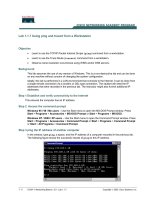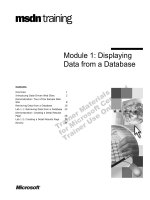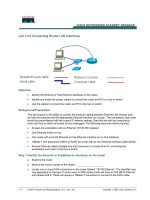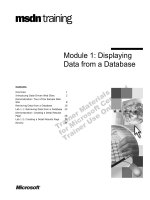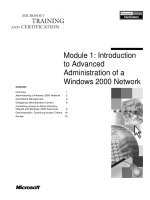Tài liệu UNIT 1. ONLINE COMMUNITIES: A NEW OPPORTUNITY LESSON 1. WHY YOU SHOULD USE THIS MODULENOTE docx
Bạn đang xem bản rút gọn của tài liệu. Xem và tải ngay bản đầy đủ của tài liệu tại đây (2.79 MB, 21 trang )
1. Online Communities: a new opportunity - 1. Why you should use this module - page 1
Information Management Resource Kit
Module on Building Electronic
Communities and Networks
UNIT 1. ONLINE COMMUNITIES:
A NEW OPPORTUNITY
LESSON 1. WHY YOU SHOULD USE
THIS MODULE
© FAO, 2006
NOTE
Please note that this PDF version does not have the interactive features
offered through the IMARK courseware such as exercises with feedback,
pop-ups, animations etc.
We recommend that you take the lesson using the interactive courseware
environment, and use the PDF version for printing the lesson and to use as a
reference after you have completed the course.
1. Online Communities: a new opportunity - 1. Why you should use this module - page 2
At the end of this lesson, you will be able to:
• define online communities and networks;
• identity the benefits of using online
communities and networks;
• recognize the importance of online
communities as facilitators of knowledge and
information exchange.
Objectives
What is an online community
Recently, Information and Communication
Technologies (ICT) have greatly increased
the channels through which communities can
function, to the point that some can exist
“virtually” without any physical contact. The
key factor in this change has been computer-
mediated communication and information
dissemination (e.g. e-mail, web).
These new communities are called electronic
(or online) communities.
Traditionally, the communities
that we worked in and that we
learned from were principally
confined to those that we could
contact physically – i.e. people in
our organization, town or
geographic region.
1. Online Communities: a new opportunity - 1. Why you should use this module - page 3
Broadcast media, such as television,
are characterized by one-way
information flow: from sender
(active) to receivers (passive).
Online communities are made possible by a special characteristic of the Internet: the
possibility of a two-way flow of information.
With e-mail based interactive tools, the
communication flows both ways:
each person can be a sender and a
receiver.
Broadcast media
What is an online community
Internet
What is an online community
There is a temptation to define an online
community by the technology it uses. A
community is not a tool! It is a group of
people who may use a certain tool or tools
to interact.
In other words, a mailing list is not a
community, but an online community may
communicate entirely via the mailing list.
People define the community, the
tools simply define how the community
interacts.
1. Online Communities: a new opportunity - 1. Why you should use this module - page 4
Benefits of an online community
The two key points here are:
• practice, collaboration with others
allows us to test our ideas, get feedback
and interact in ways that we might not
be able to do if we were working or
learning alone; and
• connections, the relationships we
make during this process not only help
us, but also indirectly help those outside
the immediate community as we
become more effective.
Alice
Alice
… a way that will allow us to learn
and work together, communicating
quickly and cheaply… it would be a
great opportunity!
Communities offer us the power of learning and working together. We can impact
our combined performance when we are driven by a shared purpose, when we act to put
our ideas into practice, and when we enhance the connections we form with each other.
Let’s make Alice’s acquaintance and see the reason why she thinks an online
community would be a great opportunity …
Alice is the Managing Director of the Regional Association for Sustainable Agriculture
(RASA).
…we no longer have the
time to answer every
question, nor do we know
all the answers, but our
members do…
Benefits of an online community
RASA’s mission is to strengthen cooperation among its members through the dissemination
and exchange of information, experiences and research results.
RASA’s team has been publishing a newsletter for almost 10 years. They get many
letters and increasing numbers of e-mail messages from readers, who are mainly staff
members of agricultural research institutes and non-governmental organizations
…a great chance would
be to involve
our readers
and regular contributors in
an online community
where everyone can share
their knowledge freely!
1. Online Communities: a new opportunity - 1. Why you should use this module - page 5
In essence, an online community is a group of
people who interact over time through
electronic channels, and who are bound
together by:
• a shared interest or purpose;
which is a cornerstone for
• strengthened social relationships.
Let’s look at these last two characteristics in
detail…
However, Alice knows that simple exchanges
of e-mail between divisions of an organization
don’t constitute an online community! In fact,
an online community is not merely a group of
people who communicate online.
The concept of “Community” is affected by
the nature and quality of relationships and
communication, and relates to a shared vision
and purpose.
Characteristics of an online community
A shared interest or purpose is a community’s “reason for existence”.
The nature of this purpose may vary enormously: from culture, to health, education,
business, hobbies…
People join a community for various reasons: for support, topical focus, professional
development, information and ideas, learning and networking
Shared interests
Community
of Interest
Community
of Interest
Community
of Practice
Community
of Practice
E-learning
Community
E-learning
Community
Distributed
Team
Distributed
Team
Online events
and Meetings
Online events
and Meetings
Would you like to know more about Communities of practice?
See a mini-lesson on this topic in Annex 1.1.1
1. Online Communities: a new opportunity - 1. Why you should use this module - page 6
Online communities are almost as diverse as their offline counterparts. What brings people
together online might be as basic as a shared interest such as…
…or food …
The Liverpool Way
… football …
Slow Food
Community
of Interest
Community
of Interest
Shared interests
What brings people together online might be a desire to improve a particular practice.
In the field of agriculture, natural resource management, and rural development there
are many such communities, for example…
… or a group of specialists in sustainable
rice production and marketing…
… Open Forum on Participatory Geographic
Information Systems and Technologies …
…a forum on participatory use of geo-spatial
information systems and technologies…
Sustainable rice workspace
Community
of Practice
Community
of Practice
Shared interests
1. Online Communities: a new opportunity - 1. Why you should use this module - page 7
E-learning is the second fastest growing segment in online interaction (online events is the first).
Educational institutions along with business and civic organizations are looking for “faster, better,
cheaper” ways to help their constituents learn. So they are moving online.
Without editorializing on the “faster, better, cheaper” goals, here are some things to consider
Applications include:
- Academic offerings/ “classes”;
- Formal sequenced training; and
- As needed, or “just in time” training.
Key skills include:
- Subject matter expertise;
- Training expertise;
- Facilitation; and
- Cybrarianship, or linking people to
relevant content and contacts.
The Information Management
Resource Kit (IMARK) is an e-
learning community. Its goal is to
train individuals and support
institutions and networks world-
wide in the effective management
of agricultural information.
/>E-learning
Community
E-learning
Community
Shared interests
These are groups with a strong task, work orientation or subject focus, where priority may be given
to a specific topic, timelines, task lists, commitments and process.
This can be aided by the use of static web pages to organize information, the combined use of
linear and threaded conferencing spaces, and the regular use of summaries and reviews. Skills
include traditional project management and organizing.
An example of a distributed team is the discussion group of WRB (World Reference Base for Soil Resources)
on Luvisols, Acrisols, Alisols and Lixisols.
Distributed
Team
Distributed
Team
Shared interests
/>1. Online Communities: a new opportunity - 1. Why you should use this module - page 8
Online events, like offline events, can provide a focal point for an online migration, or regular
punctuation for communities to stop, reflect, touch base or work intensively for a short period of time.
They can make a break from ongoing activities to connect and focus or, like a workshop, they can
focus a group on tasks and deliverables within a fixed time frame.
An example of online events is the course on
High Performance Scientific
Teams
organized by the CGIAR Gender and Diversity Program in fall 2002.
Online events
and Meetings
Online events
and Meetings
Shared interests
From the following examples, please state which ones might be considered an online
community.
A Brazilian group has created a web page with resources on
preventing HIV/AIDS in youth and made it available on the Internet.
A group of agricultural researchers spread across the globe use an
e-mail list to share key research milestones, share data and help
each other solve problems.
Five policy makers from different countries working on rural
education “meet” in an online chat room once a month to discuss
current policy issues – their “virtual lunch” – to improve their
practice as policy makers.
An organization’s manager decided he wanted his staff to share
information so he subscribed them all to an e-mail list.
Please select the answers of your choice (2 or more) and press
Check Answer.
Shared interests
1. Online Communities: a new opportunity - 1. Why you should use this module - page 9
Communities concern people, and as such
depend on social relationships. People with
shared interests, professional or economic,
are interconnected through loose social
“networks”. Online communities exist
within and between such networks.
Networks have boundaries that are not
clearly defined (
fuzzy
), and there is often no
central organizing structure to them. They
often contain clusters or nodes where
relationships are closer. Organizations or
communities serve as those nodes.
Social networks
Why do Networks Matter to Communities?
Networks are like resource banks for communities.
Most communities, online and offline, exist within larger networks. These networks are very important as
they offer a source of new members and ideas, as well as a place to send out new ideas from
communities. They may help form relationships as well as spread the word about a community’s work.
For example, an online community of rice researchers may belong to a larger global network of
agricultural researchers. It may share part of its membership with a network of agricultural ministries
and extension workers.
When ideas need to be disseminated by the rice researchers, they can do this more quickly if they have
nurtured connections to these larger networks. If new knowledge or information is needed, it can be
sought through the networks.
Metcalf’s Law: the value of networks increases geometrically with the number of
networks. In other words, the more connection points, the more valuable the
network.
Social networks
1. Online Communities: a new opportunity - 1. Why you should use this module - page 10
Sharing knowledge to achieve a purpose or goal
Online communities members have
the capacity to share and
generate knowledge and
information:
• often members’ knowledge and
information can be captured from
the community’s electronic
communications and passed on
over offline media;
• this “captured” knowledge and
information is not always in useful
forms, so one thing to consider in
your community design is how to
manage, extract and use these
resources.
Sharing knowledge
Think of communities of practice in the public,
private, or informal sectors. Envision people
working within or between organizations on
projects such as the following:
• AIDS educators sharing ideas on how to reach
target populations;
• IT managers working through problems
around introducing new software; or
• agricultural researchers sharing data on
field trials and implementation approaches.
These are learning communities which, although
distributed, support specific goals such as
preventing AIDS in rural communities or
perfecting a new drought-resistant crop variety…
Online interaction represents a powerful tool for learning and knowledge sharing.
Sharing knowledge to achieve a purpose or goal
1. Online Communities: a new opportunity - 1. Why you should use this module - page 11
• rural communities may use online
consultation to communicate with
and inform the organizations who
provide them with services, and so
try to improve the quality of those
services;
• rural communities could create
online learning groups that
recognize and strengthen community
knowledge.
… Let’s enlarge this thinking beyond the organizations to the wider communities they
serve:
Online interaction can meaningfully contribute to these efforts. It can provide the means to
connect people to gather knowledge and experience critical to organizational development,
but more importantly, contribute towards achieving community and organizational goals.
Sharing knowledge to achieve a purpose or goal
Using this module
The course addresses:
1. people who are thinking of forming an
online community;
2. members of online communities; and
3. coordinators and facilitators of online
communities.
After completing the module, you will:
• understand the possibilities, opportunities
and challenges of using ICTs to enhance
existing methods of collaboration and
information sharing; and
• be able to create and implement a plan to
use electronic networking with other media
to improve communication, information
sharing and learning among communities
and peer groups.
This module provides the strategic, interpersonal and technical skills needed in order to
build and manage electronic communities and networks.
The module is designed as a self-paced course. You can tailor your Personal Learning
Path to your needs and interests.
1. Online Communities: a new opportunity - 1. Why you should use this module - page 12
Using this module: a scenario
Alice
Alice
Ibrahim
Ibrahim
Chinwe
Chinwe
José
José
Do you remember Alice? Let’s meet also her colleagues of the Regional Association
for Sustainable Agriculture (RASA), Ibrahim, Chinwe and José…
RASA’s mission is to strengthen cooperation among their members through
the dissemination and exchange of information, experiences and
research results. Alice and her colleagues have been publishing a newsletter
for almost 10 years. They get many letters and increasing numbers of emails
from readers, who are mainly staff members of agricultural research institutes
and non-governmental organizations. They would like to involve their readers
and regular contributors in an online community where everyone can share
their knowledge more freely.
Using this module: a scenario
Alice, Ibrahim, Chinwe and José will each be completing part of the IMARK Module.
But each of them has different needs and interests.
Alice is the Managing Director of the
Association.
Alice
Alice
I’m open to the idea, but what are the
costs and benefits? How do we define
success? The Board of Directors meets
next week and they have some
questions about how this fits within our
strategy. I’d like to see a more detailed
plan before we proceed.
Alice needs:
3 An overview of benefits and opportunities offered by online communities (Unit 1)
3
A general overview of the planning steps and timelines that can be expected (Unit 2)
Alice’s Personal Learning Path should focus on strategic issues and organizational
requirements. She can skip parts of Units 3-5.
1. Online Communities: a new opportunity - 1. Why you should use this module - page 13
Using this module: a scenario
Alice, Ibrahim, Chinwe and José will each be completing part of the IMARK Module.
But each of them has different needs and interests.
Ibrahim is the systems administrator
and Web site manager. He is the
technical advisor on this project.
Should we consider adding a
discussion platform to our Web site?
Who are the participants? What kind
of Internet access do they have? Is
Open Source an option? I might have
to train users.
Ibrahim
Ibrahim
Ibrahim needs:
3 An overview of benefits and opportunities offered by online communities (Unit 1)
3 Understanding of the environmental and organizational context (Unit 2)
3 Complete knowledge of technical options (Unit 3)
3 Complete knowledge of how to design an online community (Unit 4)
3
A general understanding of the role of the facilitator (Unit 5)
Ibrahim should cover all the units, but with a focus on units 2-4. He may be able to skip parts
of units 1 and 5.
Using this module: a scenario
Alice, Ibrahim, Chinwe and José will each be completing part of the IMARK Module.
But each of them has different needs and interests.
I need to build a team and get
commitment from Management. We
need to do a thorough needs analysis. I
don’t expect to be involved from day to
day. Let’s make sure we have a sound
strategy in place, and that we have a
system for monitoring and
evaluation so we can learn from the
experience. How should we promote the
community?
Chinwe is the head of the Outreach Programme
and the coordinator of this project.
Chinwe
Chinwe
Chinwe needs:
3 An overview of benefits and opportunities offered by online communities (Unit 1)
3 In-depth understanding of the environmental and organizational context (Unit 2)
3 Complete knowledge of technical options (Unit 3)
3 General knowledge of how to design an online community (Unit 4)
3
A general understanding of the role of the facilitator (Unit 5)
Chinwe should complete all the units, but she does not need to acquire technical and
facilitation skills in depth. She may be able to skip some Lesson steps in Units 4 and 5.
1. Online Communities: a new opportunity - 1. Why you should use this module - page 14
Using this module: a scenario
Alice, Ibrahim, Chinwe and José will each be completing part of the IMARK Module.
But each of them has different needs and interests.
José is the editor of the newsletter. He will
be the main facilitator of the new network.
José
José
“I’m a communicator, not a computer
expert!” “Many of our readers don’t have
access to e-mail. How can we ensure that
their views are represented?” “I plan to start
off the debate with a look at some recent
case studies of genetically modified
organisms. People have such strong opinions
on GMOs. How can I keep the tone of the
discussion positive and constructive?”
José needs:
3 An overview of benefits and opportunities offered by online communities (Unit 1)
3 In-depth understanding of the environmental and organizational context (Unit 2)
3 General knowledge of technical options (Unit 3)
3 General knowledge of how to design an online community (Unit 4)
3
In-depth understanding of the role of the facilitator (Unit 5)
José should complete all of Unit 5 and parts of the other Units.
What is covered and what is not
The module includes information on:
•
how to assess the needs of your stakeholders and the institutional capacity
of your organization to support different technologies:
•
the range of technology choices available: and
•
how to balance different needs and priorities in selecting technologies.
This course does not recommend or give
advice on how to use specific hardware
and software to support your community.
The aim instead is to provide you with
information you need for strategic
planning and decision-making.
The course will guide you through the
steps required make appropriate software
and hardware choices, depending on
your resources, capacities, and the needs
of your audience.
1. Online Communities: a new opportunity - 1. Why you should use this module - page 15
The module is mainly designed for
people with a shared interest in
agriculture, Natural Resource
Management (NRM), and rural
development.
But also people working in any other
field of development (health, education,
governance, etc.) can benefit from this
course.
What is covered and what is not
The primary target audience for the
course are organizations working in
“resource poor” contexts, where
the latest hardware and software
may not be available, affordable, or
even appropriate to the users.
Therefore the emphasis in this course
is on low-cost, accessible solutions.
I work in health, not in
rural development. Is this
module useful for me?
The focus of the course is on the
use of ICTs for electronic networks
and communities. Other applications
of ICTs in support of agriculture, NRM
and rural development are not covered,
such as the use of rural radio, or the
design of agricultural information
databases. Many of these subjects are
dealt with in the other Modules in the
IMARK series.
What is covered and what is not
This course doesn’t explain how to
use ICTs in general (see resources on
next page). You will not find information
on topics such as how to use a
computer, or how to use e-mail and the
Web. It is assumed that the learners
have access to a computer, basic access
to the Internet, and that they have a
basic knowledge of how to use these
tools.
1. Online Communities: a new opportunity - 1. Why you should use this module - page 16
Online resources on how to use ICTs
/> /> /> /> /> /> />What is covered and what is not
The emphasis of the course is on
practice, not on theoretical issues in
great depth.
One of the first principles of electronic
networking is that it should be driven
by the needs and interests of the
people and organizations involved.
However, more in-depth readings on
the technical issues raised are listed in
the Online Resources and Additional
Reading collections.
What is covered and what is not
1. Online Communities: a new opportunity - 1. Why you should use this module - page 17
Summary
An online community is a group of people who interact over time and are bound together by a
shared interest or purpose, which provides the cornerstone for social networks.
Online communities have the capacity to share and generate knowledge and information and
offer the power of learning and working together.
Characteristics of this module:
• is mainly designed for coordinators, facilitators of online communities, and people who
are thinking of forming an online community;
• provides the strategic, interpersonal and technical skills needed in order to build online
communities;
• focuses on the needs of “resource poor” organizations and emphasizes simple,
accessible, and low-cost technologies;
• is mainly designed for people with a shared interest in agriculture, NRM and rural
development, but it will also be useful for people working in other development sectors
such as health and governance; and
• is not technical - is about human networks, not computer networks.
If you want to know more…
White, N. (1999, 2005) “How Some People Have Tried to Describe Community” at
/>White, N (various) “Online Community Toolkit” at />Smith, M. K. (2001) 'Community' in
the encyclopedia of informal education
,
/>.
Commonwealth of Learning, 2000. Introduction to Open and Distance Learning
/>Canadian Association for Community Learning/FuturEd, 2002. Consumer’s Guide to e-Learning.
/>Yahoo! Directory: list of sites containing guides, tips and tricks, forums, tutorials, and other advice on computer
and Internet. />Computer Hope: collection of free services that allows users to access a database of extensive free computer
related information. />Howstuffworks "Computer Channel“: how computers work inside and out.
/>Computer Help A to Z: free computer tips, ideas and articles to help you get more from your computer.
/>CyberTechHelp: help and technical support for all windows and macintosh operating systems, hardware,
software, web design, and Internet issues. />Online resources
1. Online Communities: a new opportunity - 1. Why you should use this module - page 18
If you want to know more…
Brown, John S., Duguid, Paul. 2002. The Social Life of Information. Published by Harvard Business School
Press, Boston, MA. ISBN 1-57851-708-7.
Kim, Amy Jo, Community Building on the Web : Secret Strategies for Successful Online Communities.
2002, PeachPit Press. San Francisco.
Powazek, Derek M., Design for Community, 2002, New Riders, Indianapolis,
ISBN 0735710759.
Additional readings
Online resources
Personal computer from Wikipedia, the free encyclopedia.
/>Computerbb.org: computer help. />1. Online Communities: a new opportunity - 1. Why you should use this module - page 19
We are core members of some
and we belong to others more
peripherally (for example, you
may be a member of a band, or
you may just come to rehearsals
to hang around with the group).
Whatever form our participation
takes, most of us are familiar with
the experience of belonging to a
community of practice.
Members of a community are
informally bound by what they
do together and by what they
have learned through their mutual
engagement in these activities.
Communities of practice are everywhere. We all belong to a number of them, at work,
at school, at home, in our hobbies.
A community of practice is thus different from a community of interest or a geographical
community, neither of which implies a shared practice.
Annex 1.1.1
Mini-lesson: Communities of Practice (CoPs)
A community of practice defines itself along three dimensions:
What it is about, its
joint enterprise
as understood and
continually renegotiated by its members;
How it functions, mutual engagement that binds members
together into a social entity; and
What capability it has produced, the
shared repertoire
of
communal resources (routines, sensibilities, artifacts, vocabulary,
styles, etc.) that members have developed over time.
1
2
3
1. Online Communities: a new opportunity - 1. Why you should use this module - page 20
Communities of practice also move through various stages of development
characterized by different levels of interaction among the members and different
kinds of activities:
People belong to communities of practice - where they develop the knowledge that
lets them do these other tasks - at the same time as they belong to other organizational
structures, such as:
• business units, where they shape the organization;
• teams, where they take care of projects; and
• networks, where they form relationships.
This informal fabric of communities and shared practices makes the official organization
effective and, indeed, possible.
1. Online Communities: a new opportunity - 1. Why you should use this module - page 21
Communities of practice are important to
the functioning of any organization, but they
become crucial to those that recognize
knowledge as a key asset.
An effective organization is made of various
interconnected communities of practice,
each dealing with specific aspects of the
organization's competencies.
Knowledge is created, shared, organized,
revised, and passed on within and among
these communities.
In a deep sense, these communities "own"
knowledge in practice.
